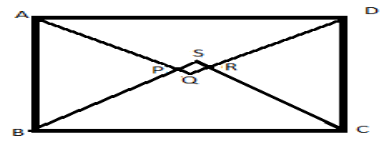Answer
424.8k+ views
Hint: A quadrilateral is a polygon having four sides and four vertices. A quadrilateral is cyclic when all of its vertices lie on a circle.
A cyclic quadrilateral is given by the following figure:

A quadrilateral formed by the internal angle bisectors of a quadrilateral ABCD is PQRS:

We need to prove PQRS is cyclic.
A rule of angle equality is, vertically opposite angles are equal.
Angle sum property of a triangle gives the sum of all angles of a triangle = ${180^0}$
To prove the quadrilateral PQRS is cyclic, it is enough to prove that the sum of opposite angles of PQRS is ${180^0}$ . Implies $\angle SPQ + \angle SRQ = {180^0}$
Complete step-by-step answer:
Step 1: Consider a quadrilateral ABCD with internal bisectors AQ, BS, CS, DQ of angles $\angle A$, $\angle B$ , $\angle C$ and $\angle D$ respectively. We need to prove the quadrilateral PQRS formed by these four internal angle bisectors is cyclic.
As vertically opposite angles are equal, we obtain the following equalities:
$
\angle SPQ = \angle APB \\
\angle SRQ = \angle DRC \\
$
Adding above two formulas we get $\angle SPQ + \angle SRQ = \angle APB + \angle DRC$
As AQ is the angle bisector of $\angle A$ and P is a point on AQ, By angle sum property,
$\angle APB = 180 - (\dfrac{1}{2}\angle A + \dfrac{1}{2}\angle B)$ and $\angle DRC = 180 - (\dfrac{1}{2}\angle D + \dfrac{1}{2}\angle C)$ . Thus,
$
\angle SPQ + \angle SRQ = \angle APB + \angle DRC \\
= 180 - (\dfrac{1}{2}\angle A + \dfrac{1}{2}\angle B) + 180 - (\dfrac{1}{2}\angle D + \dfrac{1}{2}\angle C) \\
= 360 - \dfrac{1}{2}(\angle A + \angle B + \angle C + \angle D) \\
= 360 - \dfrac{1}{2}(360) \\
= {180^0} \\
$
The sum of opposite angles of quadrilateral PQRS is ${180^0}$ . Thus PQRS is a cyclic quadrilateral.
Hence proved.
The quadrilateral formed by internal angle bisectors of a quadrilateral is cyclic.
Note: Students should always draw a diagram for better understanding of such questions. Also, they should avoid writing the angles in one letter when taking in consideration a figure where there are several other angles which might seem like the same.
Kite, Trapezoid, Parallelogram, Square, Rhombus, Rectangle comes under Quadrilateral.
A cyclic quadrilateral is given by the following figure:

A quadrilateral formed by the internal angle bisectors of a quadrilateral ABCD is PQRS:

We need to prove PQRS is cyclic.
A rule of angle equality is, vertically opposite angles are equal.
Angle sum property of a triangle gives the sum of all angles of a triangle = ${180^0}$
To prove the quadrilateral PQRS is cyclic, it is enough to prove that the sum of opposite angles of PQRS is ${180^0}$ . Implies $\angle SPQ + \angle SRQ = {180^0}$
Complete step-by-step answer:
Step 1: Consider a quadrilateral ABCD with internal bisectors AQ, BS, CS, DQ of angles $\angle A$, $\angle B$ , $\angle C$ and $\angle D$ respectively. We need to prove the quadrilateral PQRS formed by these four internal angle bisectors is cyclic.
As vertically opposite angles are equal, we obtain the following equalities:
$
\angle SPQ = \angle APB \\
\angle SRQ = \angle DRC \\
$
Adding above two formulas we get $\angle SPQ + \angle SRQ = \angle APB + \angle DRC$
As AQ is the angle bisector of $\angle A$ and P is a point on AQ, By angle sum property,
$\angle APB = 180 - (\dfrac{1}{2}\angle A + \dfrac{1}{2}\angle B)$ and $\angle DRC = 180 - (\dfrac{1}{2}\angle D + \dfrac{1}{2}\angle C)$ . Thus,
$
\angle SPQ + \angle SRQ = \angle APB + \angle DRC \\
= 180 - (\dfrac{1}{2}\angle A + \dfrac{1}{2}\angle B) + 180 - (\dfrac{1}{2}\angle D + \dfrac{1}{2}\angle C) \\
= 360 - \dfrac{1}{2}(\angle A + \angle B + \angle C + \angle D) \\
= 360 - \dfrac{1}{2}(360) \\
= {180^0} \\
$
The sum of opposite angles of quadrilateral PQRS is ${180^0}$ . Thus PQRS is a cyclic quadrilateral.
Hence proved.
The quadrilateral formed by internal angle bisectors of a quadrilateral is cyclic.
Note: Students should always draw a diagram for better understanding of such questions. Also, they should avoid writing the angles in one letter when taking in consideration a figure where there are several other angles which might seem like the same.
Kite, Trapezoid, Parallelogram, Square, Rhombus, Rectangle comes under Quadrilateral.
Recently Updated Pages
How many sigma and pi bonds are present in HCequiv class 11 chemistry CBSE

Why Are Noble Gases NonReactive class 11 chemistry CBSE

Let X and Y be the sets of all positive divisors of class 11 maths CBSE

Let x and y be 2 real numbers which satisfy the equations class 11 maths CBSE

Let x 4log 2sqrt 9k 1 + 7 and y dfrac132log 2sqrt5 class 11 maths CBSE

Let x22ax+b20 and x22bx+a20 be two equations Then the class 11 maths CBSE

Trending doubts
Fill the blanks with the suitable prepositions 1 The class 9 english CBSE

At which age domestication of animals started A Neolithic class 11 social science CBSE

Which are the Top 10 Largest Countries of the World?

Give 10 examples for herbs , shrubs , climbers , creepers

Difference between Prokaryotic cell and Eukaryotic class 11 biology CBSE

Difference Between Plant Cell and Animal Cell

Write a letter to the principal requesting him to grant class 10 english CBSE

Change the following sentences into negative and interrogative class 10 english CBSE

Fill in the blanks A 1 lakh ten thousand B 1 million class 9 maths CBSE



